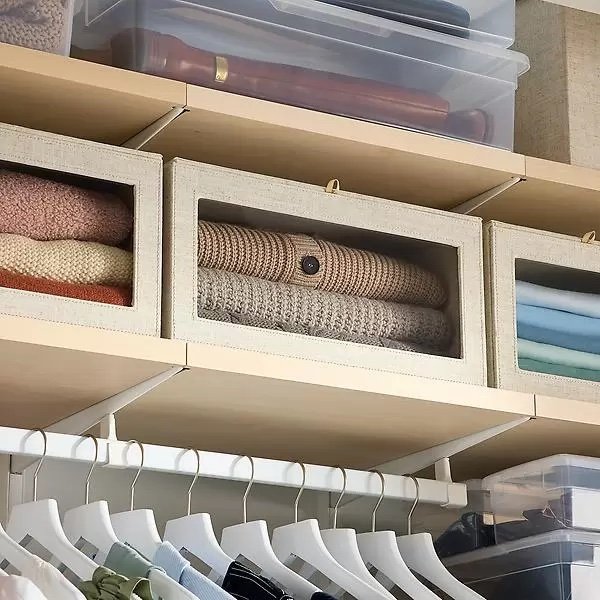By Christina DesAuguste
Christina is the founder of The Organizing Company and has been organizing professionally since 2013. She is currently loving wide leg pants (Yay! They’re back!), pumpkin everything, and nights by the firepit.
Affiliate Disclosure: Some of the links on our website are affiliate links, meaning, at no additional cost to you, we will earn a commission if you click through and make a purchase.
Your wardrobe is changing for fall and winter. Your closet may need changes too.
One of my favorite things about fall is pulling out my sweaters and jackets and boots again. It feels like I get a whole new wardrobe!
Today I’m going to walk you through some reasons why you might consider a closet “swap-out”, some tips to keep it organized, and some reminders to make sure you don’t forget anything.
So, first of all, why would anyone need to do a closet refresh when the seasons change?
Many of my organizing clients have large closets that are able to accommodate all of their clothes and shoes. And I also have clients who are minimalists who don’t have large closets, but are committed to live within the confines of the closets they do have. In both of these cases, a seasonal swap-out may not be necessary. If all your clothes are within reach year round there isn’t a need to change things to make seasonal items more reachable.
But there is one reason why I still recommend a fall closet refresh to people in these situations.
Your brain can “tune out” things it sees often. The off-season clothes in your closet become visual clutter. When we’re used to seeing things the same way all the time we stop noticing some things. It’s almost like they blend into the background.
If you find that you are falling into that statistic that you’re only wearing 20% of your wardrobe, then it could be because your closet stays the same all year and you just reach for your favorite things that are in the same place all year, and you only mix it up when you have to hunt for something specific for the colder months.
In Colorado you might even be able to get away with wearing the same jeans all year and the same cardigans and hoodies. You could especially get away with wearing the same clothes all year here if you work in an office setting that is business casual or business formal and they blast the AC in the summer so you need long sleeves/pants year round.
Psst: More on the challenges climates like Boulder and Denver face later!
So, if your closet stays the same all year, you might be missing out on items that you’ve forgotten about. So I recommend changing things up for the new season and moving pieces you normally gravitate towards to those harder to reach places (like awkward corners and high shelves) and pulling things to the front/down lower that you forgot you had, or that are more seasonally appropriate. It will feel like, “Oh my gosh! I haven’t seen this in so long! I love this dress!”
It will illuminate the ways that you’ve gotten in a rut with your wardrobe and give you the push to be more creative and better utilize the clothing and accessories you have.
It will make your closet and your wardrobe feel new again. And who doesn’t love new things?
So what about the rest of us? The reasons here might be a bit more obvious.
I can actually fit all of my clothes on my half of my primary closet and in my dresser. But the off-season items are in bins/boxes too high to reach on a daily basis.
So for me, the reason I do seasonal swap-outs is ease of access. I want my sweaters down lower and I can move my sundresses to a bin up high. This is one of the basic principles of organizing: put things you use most in the easiest to access places. Sometimes that just means a swap twice a year.
Psst: This is my professional recommendation, as opposed to moving off-season items to a guest closet/basement/garage.
But I know that space is a real issue for a lot of people. Especially if you live in an old house. Closets built 100 years ago weren’t built for the 2024 American way of life. Shoot. Closets built in the ‘70s weren’t even built for how we live today.
We can debate the pros/cons and morality of that issue another time perhaps, but I also want to give practical advice for problems a lot of people have. So for some of you, your seasonal closet refresh will be more of a true swap-out, moving things out of the space to create more breathing room for what is in-season. You know this is true for you if you have recently curated your wardrobe (more on curating here if you’re new to my method) yet still find that it is too packed. It’s hard to get hangers in/out, it’s hard to fit all your tees in the drawer and you feel like you need to vacuum seal things to create more space. If you’re in this situation you may also notice that, because it’s too hard to put items back where they belong, they just don’t get put back properly.
That’s your cue that it’s a good idea to move your off-season items out of the closet.
So if you must move things out, make sure you have a “method to the madness”, keeping everything in one place and making sure it’s labeled well in case you need something.
Speaking of labeling, let’s talk about how to store your off-season items.
Whether you are storing things in your closet or elsewhere in the house, I strongly recommend storing them in their categories.
Instead of just having 3 bins labeled “Off-Season Clothes”, I like to separate them by tops/bottoms/dresses/undergarments/etc. So I would keep all my summer dresses together and put them in a bin labeled “Summer Clothes: Dresses & Tops” (or whatever else is in there).
This is one of the things that will help you a lot if you live somewhere like Boulder where the weather does funny things and you might want shorts in December.
Having your bins labeled means you can quickly find your shorts, or your beach cover-ups for that unplanned vacation you get to take this winter.
Coloradans can also benefit from leaving out a highly curated selection of items that you usually use, even in the off season. I stress that it’s a selection, because you remember all the reasons doing the swap-out was important in the first place. Plus, if you need a pair of jean shorts this winter, chances are you can get away with just one pair.
Keeping this selection of off-season items accessible may be a bigger issue in the summer when you might be hiking or doing activities at high elevation where you need heavier pieces that you don’t need down in the city.
But, whatever your reason for keeping a few items more accessible, we know that most things can be put away. I don’t care how hot it is in Boulder in January, you’re not going to bust out a pastel Easter-type sundress, or a 4th of July t-shirt, or those white jean shorts with the daisy appliqués. You’re going to choose items that are better colors, patterns, and fabrics for the season.
Want to make sure you don’t forget anything? Or not sure if something is a faux pas?
I put together a quick list of basic fashion rules and a checklist to make sure you don’t miss a thing!
Psst: Some year round items like jean jackets, athletic sneakers, and underwear don’t need a swap! ;)
One bonus note on seasonal clothing:
Black is not usually considered exclusively a winter color anymore. Especially if you are “city folk”. I actually had an employee once who kept asking if we could wear khakis in the summer for our uniform instead of black pants and I never understood the question. First of all, khakis are never a yes, so I thought she meant Chinos. But I didn’t understand that she meant that wearing black in the summer felt weird to her. Rest easy, that’s an outdated rule and black can be worn year round when you consider the material and the style.
As for other tips on how to store your off-season clothes, here are a couple thoughts:
I store my sweaters in these drop front bins from The Container Store year-round. In the summer they are just up high out of reach, and in the fall I move them down to waist/chest height to be able to grab my sweaters without a step stool.
They come in other colors too!
These boxes also come in other sizes that I use for more narrow items like ponchos, vests, and handbags (pro tip: You can turn them vertically for handbags! I’ve used the larger, sweater size boxes above turned on their sides for large totes and bags too. And once for tall boots!). Over the years I’ve personally used them for shoe storage too (keeping my suede booties dust free!).
In clients’ homes I often utilize a coordinating lidded box from this Cambridge line at TCS for off-season clothes. Sometimes it just swaps out what’s in it from summer to winter (and I label both sides of the label so the client can just flip it to the other side to easily see what’s in which box), and sometimes it just moves from up high on a shelf with the lid on to down low on a shelf with the lid off during the “on-season”.
Personally, I like these fabric boxes and bins better than clear plastic. But here is my favorite plastic line, just in case it makes more sense for you.
Either way, make sure you are LABELING so you can see what’s in a bin even if you can’t actually see what’s in a bin.
If you are storing your clothes/shoes/handbags in your garage or attic or crawlspace, I DEFINITELY recommend these weathertight bins. They will protect your garments from critters and water; both of which are much more likely in these exterior storage spaces.
Well, that’s it for now. Follow along on IG for more tips on this, and let me know what questions come up for you.
Here’s that link to the free swap checklist and guide to fall fabrics and colors, one more time.
Happy Organizing and Happy Fall!
Christina
PS: If you’re feeling like, “This is great, but I’m not that organized yet to even have my clothes in categories to store away!” Don’t worry. I’ve got you.
Before you dive into making seasonal changes, you probably need to get some basic organization going. I have a free video guide (it’s only 9 minutes) explaining my organizing method so you can tackle any room in your house. I also include a bonus cheatsheet PDF so you can print out my method to have it handy as you work.
September 19, 2024
Share & Follow









